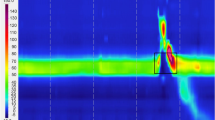Abstract
The Mendelsohn maneuver, voluntary prolongation of laryngeal elevation during the swallow, has been widely used as a compensatory strategy to improve upper esophageal sphincter (UES) opening and bolus flow. Recent research suggests that when used as a rehabilitative exercise, it significantly improves duration of hyoid movement and positively impacts duration of UES opening (DOUESO). The data presented here were derived from that same prospective crossover study of 18 participants with dysphagia post-stroke evaluated with videofluoroscopy after treatment using the Mendelsohn maneuver versus no treatment. Results demonstrate gains in the extent of hyoid movement and UES opening and improvements in coordination of structural movements with each other as well as with bolus flow.





Similar content being viewed by others
References
Mendelsohn MS, McConnell FM. Function in the pharyngoesophageal segment. Laryngoscope. 1987;97(4):483–9.
Dodds WJ, Stewart ET, Logemann JA. Physiology and radiology of the normal oral and pharyngeal phases of swallowing. AJR Am J Roentgenol. 1990;154:953–63.
Crary MA, Carnaby GD, Groher ME, Helseth E. Functional benefits of dysphagia therapy using adjunctive sEMG biofeedback. Dysphagia. 2004;19:160–4.
Kim Y, McCullough GH. Maximal hyoid excursion in poststroke patients. Dysphagia. 2010;25(1):20–5.
Lazarus C, Logemann JA, Gibbons P. Effects of maneuvers on swallowing function in a dysphagic oral cancer patient. Head Neck. 1993;15:419–24.
Lazarus C, Logemann JA, Song CW, Rademaker AW, Kahrilas PJ. Effects of voluntary maneuvers on tongue base function for swallowing. Folia Phoniatr Logop. 2002;54:171–6.
Burkhead L, Sapienza CM, Rosenbek J. Strength-training exercise in dysphagia rehabilitation: principles, procedures, and directions for future research. Dysphagia. 2007;22:251–65.
Bryant M. Biofeedback in the treatment of a selected dysphagic patient. Dysphagia. 1991;6:140–4.
Huckabee ML, Cannito MP. Outcomes of swallowing rehabilitation in chronic brainstem dysphagia: a retrospective evaluation. Dysphagia. 1999;14:93–109.
McCullough GH, Kamarunas E, Mann GC, Schmidley JW, Robbins JA, Crary M. Effects of Mendelsohn maneuver on measures of swallowing duration post-stroke. Top Stroke Rehabil. 2012;19:234–43.
Park T, Kim Y, McCullough GH. Oropharyngeal transition of the bolus in poststroke patients. Am J Phys Med Rehabil. In press. doi:10.1097/PHM.0b013e318269d935.
Perlman AL, Booth BM, Grayhack JP. Videofluoroscopic predictors of aspiration in patients with oropharyngeal dysphagia. Dysphagia. 1994;9:90–5.
Kim Y, McCullough GH. Maximum hyoid displacement in normal swallowing. Dysphagia. 2008;23:274–9.
Logemann JA, Pauloski BR, Rademaker AW, Colangelo LA, Kahrilas PJ, Smith CH. Temporal and biomechanical characteristics of oropharyngeal swallow in younger and older men. J Speech Lang Hear Res. 2000;43:1264–74.
Rosenbek JC, Robbins JA, Roecker EB, Coyle JL, Wood JL. A penetration-aspiration scale. Dysphagia. 1996;11:93–8.
McCullough GH, Rosenbek JC, Robbins JA, Coyle JL, Wood JL. Ordinality and intervality of a penetration-aspiration scale. J Med Speech Lang Pathol. 1998;6:65–72.
Robbins JA, Kays SA, Gangnon RE, Hind JA, Hewitt AL, Gentry LR, Taylor AJ. The effects of lingual exercise in stroke patients with dysphagia. Arch Phys Med Rehabil. 2007;88:150–8.
O’Neil KH, Purdy M, Falk J, Gallo L. The dysphagia outcome and severity scale. Dysphagia. 1999;14:139–45.
Nakane A, Tohara H, Ouchi Y, Goto S, Uematsu H. Videofluoroscopic kinesiologic analysis of swallowing: defining a standard plane. J Med Dent Sci. 2006;53:7–15.
Acknowledgments
This research was conducted by NIH NIDCD Grant R03 DC04942-01A2.
Conflict of interest
The authors have no conflicts of interest to declare.
Author information
Authors and Affiliations
Corresponding author
Rights and permissions
About this article
Cite this article
McCullough, G.H., Kim, Y. Effects of the Mendelsohn Maneuver on Extent of Hyoid Movement and UES Opening Post-Stroke. Dysphagia 28, 511–519 (2013). https://doi.org/10.1007/s00455-013-9461-1
Received:
Accepted:
Published:
Issue Date:
DOI: https://doi.org/10.1007/s00455-013-9461-1




